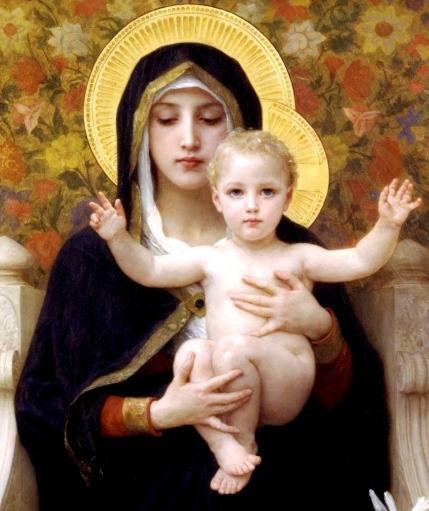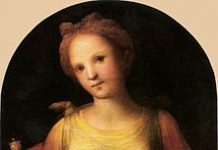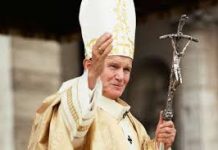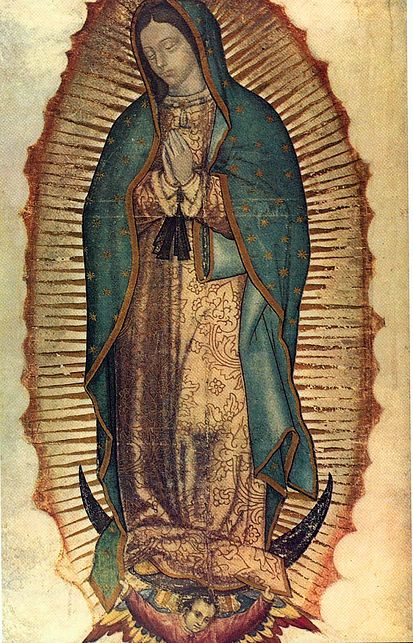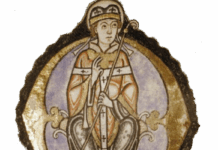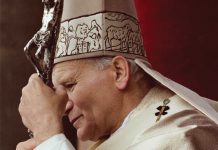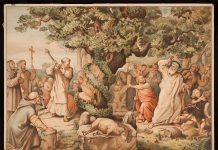January 1st begins the new calendar year and it also brings to an end the celebration of the Christmas Octave with the celebration of the Solemnity of Mary the Mother of God, a feast that celebrates the divine maternity of Blessed Virgin Mary. The coherence of these liturgical celebrations directs us to the ideal of an integration of faith and life, the work of a lifetime. As with all of the mysteries celebrated in the course of the liturgical year, their appropriation is what engages each of us in the work of sanctification or our transformation in Christ. To begin the new year under the maternal protection of Our Lady is surely a source of consolation and encouragement. She who is both our Mother and our Queen is the Chosen Daughter of Israel and the Glory of Zion whose role and function in the unfolding of the Mystery of the Incarnation we contemplated during the holy season of Advent and most especially in the latter days of this season.
Mother of the Messiah
Our Lady’s faith precedes and accompanies us as a beacon and a model of Christian maturity. We contemplate her as Mother of the Messiah but also as an exemplary model of faith in the promise of salvation. She is an exemplar of faith not only for us individually who also believe in the Lord’s words of salvation but also for the Church. Our Lady is for the Church a model and a reference point (nexus) in whom the Church recognizes herself, her vocation and her mission.
During Advent, the Roman Liturgy celebrates the plan of salvation by which the merciful God called the patriarchs, united them to Himself in a covenant of love, established the Law through Moses, raised up the prophets, and chose David as the one from whose line the Saviour of the world was to be born.
The Chosen Daughter of Israel and Noble Daughter of Zion
The books of the Old Testament, in foretelling the coming of Christ, gradually bring into clearer light the figure of a woman, the Mother of the Redeemer (Lumen Gentium, 55): She is the Blessed Virgin Mary, whom the Church proclaims as the joy of Israel and the noble daughter of Zion. In her sincere obedience to the Law and her wholehearted acceptance of God’s will, she is exalted among the humble and poor of the Lord, who trustingly hope in Him for salvation and from Him receive it. After the long period of waiting for the fulfillment of the promise, in her at last the fullness of time is reached, and a new order of providence is begun, when the Son of God takes from her a human nature in order to free the human family from sin through the mysteries of His earthly life (Lumen Gentium, 55). The preface of the Votive Mass of the Blessed Virgin Mary, Chosen Daughter of Israel summarizes God’s plan of salvation as it relates to Our Lady and likewise reminds us of a truth we risk forgetting because of the troubling normalization of anti-Semitism we are experiencing in our country and elsewhere in the world; namely, that salvation is from the Jews (Jn. 4:22). If ever there was a time for Jewish-Christian solidarity, it is now. The poetic text of the preface alludes to God’s desire that everyone to be saved and come to the knowledge of the truth (I Tim. 2: 4).
You chose the Blessed Virgin Mary
As the crown of Israel and the beginning of the Church,
to reveal to all peoples
that salvation is born from Israel
and that your new family springs from a chosen root.
She is by nature the daughter of Adam,
who by her sinlessness undid the sin of Eve.
She is by faith the true child of Abraham,
who first believed and so conceived.
She is by descent the branch from the root of Jesse,
Bearing the flower that is Jesus Christ Our Lord
That everyone be saved and come to the knowledge of the truth
The beauty and richness of the Christmas liturgy is expressed in its varied prayers and scriptural texts.The second reading of the Christmas Mass at Midnight is taken from St. Paul’s Epistle to Titus. It is a fitting summary of the Christmas Mystery and how Christians are to appropriate the Mystery that also gives birth to the Christian people.
God’s grace has been revealed, and it has made salvation possible for the whole human race and taught us that what we have to do is give up everything that does not lead to God, and all our worldly ambitions; we must be self-restrained and live good and religious lives here in this present world, while we are waiting in hope for the blessing which will come with the Appearing of the glory of our great God and saviour Christ Jesus. He sacrificed himself for us in order to set us free from all wickedness and to purify a people so that it could be his very own and have no ambition except to do good (Titus 2:11-14).
The pericope begins with a proclamation of the revelation of the mystery of salvation and God’s universal salvific will. It then proceeds to describe what is required of those who receive the gift of salvation: give up everything that does not lead to God and all our worldly ambitions, and be self-restrained and live good and religious lives here in this present world. St. John further extrapolates what contempt for the world practically implies: Do not love the world or the things in the world. If anyone loves the world, love for the Father is not in him. For all that is in the world, the lust of the flesh, and the lust of the eyes and the pride of life, is not of the Father but is of the world. And the world passes away, and the lust of it; but he who does the will of God abides for ever (2 Jn. 2:15-17).
No ambition except to do good
In the Acts of the Apostles, the book that chronicles the earliest days of the Church, in one of his sermons, the Apostle St. Peter summarizes Our Lord’s earthly ministry by saying that He went about doing good and healing all that were oppressed by the devil (Acts 10:38). In the power of the same Holy Spirit, the Church today continues this ministry of service to humanity; first, by preaching the gospel of salvation because there is salvation in no one else, for there is no other name under heaven given among men by which we must be saved (Acts 4:12); and then in the varied works of mercy that address the needs of men and women everywhere. In this sense, the Church, and by extension every Christian should have no ambition except to do good. How different things would be if this were our highest good, our summum bonum.
At the school of Mary, our Mother and our Queen
In the intimate connection among the mysteries of the Christian faith (nexus mysteriorum), Our Lady is never absent; and if we read Sacred Scripture with attention and without bias we see the truth of this Catholic approach to the Mystery of God. One does not find Jesus without going through Mary. This was true at Our Lord’s Nativity. The shepherds went with haste to Bethlehem and found Mary and Joseph and the Child lying in a manger (Lk. 2:16). And it was likewise true at the Epiphany, the twelfth day of Christmas: And going into the house they saw the Child with Mary his mother and they fell down and worshipped him (Mt. 2:11). Both St. Matthew and St. Luke present Our Lady as the Gebirah, the Queen Mother who presents her Son to the world as King (Mt. 2:2), Saviour and Lord (Lk. 2:11). The queen mother of Israel interceded on behalf of the subjects of the kingdom. She was their most powerful, and therefore preferred, advocate. She stood at the king’s right hand, a place of honour.
The grace of a new year
There is a special grace to every liturgical season. The Advent and Christmas cycle of the liturgical year prepare us for the celebration of the unfolding mystery of Christ by inviting us to adore the Christ Child, Emmanuel who remains with us in the Most Blessed Sacrament of the Altar. As we continue to celebrate the Christmas Mystery until the Feast of the Lord’s Presentation in February, let our prayer embrace the many who have celebrated the Feast of our Salvation without a spirit of profound adoration. Such a celebration is ephemeral and never transformative.
Devotion to Our Lady’s Immaculate Heart
No one was more intimately united to the Mystery of Christ than Our Lady; and from her we can learn properly to adore the living God in Christ, appropriate this Mystery into the intimacy of our life and serve Him with a profound spirit of adoration in His Eucharistic Mystery, and with a fervent spirit of charity in our service to our brothers and sisters, especially the neediest among us. Devotion and conformity to Our Lady’s Immaculate Heart will enable us to learn from her the practice of the virtues needed to grow in the grace of holiness: faith, obedience, humility, purity and charity. ‘But the hour is coming, and now is, when the true worshippers will worship the Father in spirit and in truth, for such the Father seeks to worship him (Jn. 4:23). At the beginning of this new year, we do well to remember that the present moment is the hour that now is to learn from Our Lady, our gracious advocate so that we ourselves may become gracious advocates for the many who do not believe, do not love and do not adore. In this spirit of charity, may it be our resolve in the coming year to have no ambition except to do good.

